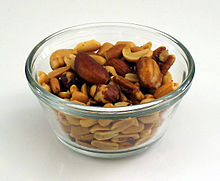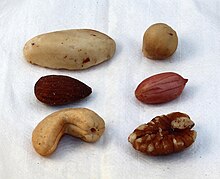食用果仁列表:修订间差异
删除的内容 添加的内容
| 第221行: | 第221行: | ||
| publisher=New Agriculturist |
| publisher=New Agriculturist |
||
| access-date=2011-04-28 |
| access-date=2011-04-28 |
||
}}</ref> |
|||
*[[油棕属|油棕果实]]:非洲[[辛巴人]]的重要应饥食品。<ref>{{citation |
|||
| url=https://books.google.com/books?id=SsPO7wYv1VkC&q=%22palm%20nuts%22%20food&pg=PA193 |
|||
| page=193 |
|||
| title=Risk management in a hazardous environment: a comparative study of two pastoral societies |
|||
| volume=2 |
|||
| work=Studies in human ecology and adaptation |
|||
| author=Bollig, Michael |
|||
| publisher=Birkhäuser |
|||
| year=2006 |
|||
| isbn=0-387-27581-9 |
|||
| access-date=2011-11-22 |
|||
}}</ref> |
}}</ref> |
||
2022年9月11日 (日) 13:51的版本


食用果仁是指脱水后的水果或植物种子,其中大部分果仁的脂肪含量较高,当然也有例外。果仁有多种食用方式,包括但不限于烘焙、即食或者用于调味。除了坚果外,可以食用的水果或植物的种子同样被视为食用果仁。[1]以下四种水果或种子可以视为食用果仁:
- 坚果:干燥、硬壳、未隔间的果实,成熟时果皮不会开裂释放种子(例如榛子)[2][3]
- 核果:植物种子被果核包裹,同时果核周围被果肉包裹(例如扁桃或核桃)[4]
- 裸子植物的种子:特点是胚珠裸露, 不為子房所包被(例如松子)
- 被子植物的种子:特点是种子有较为完整的保护构造(例如花生)
人类食用坚果的历史非常悠久。对于许多美洲原住民而言,包括橡子、美洲山毛榉等在内的各种坚果在数千年来一直是其淀粉和脂肪的主要摄取来源。[5]除此之外,澳大利亚原住民在过去数个世纪也将各种坚果当作食物。[6]很多自古以来就被人类所食用的坚果在进入现代社会后需求量急剧增加,花生就是其中的典型代表。根据植物学家乔治·华盛顿·卡弗的研究发现,种植花生可以改良棉花田的土壤,因此花生这种干果得以在美国大范围推广。[7]
坚果
以下为可食用的坚果:
- 榛子:自古以来便是美洲原住民的主食,可以用于面包烘焙或煮粥。[8]
- 山毛榉:
- 面包坚果:被古玛雅人用作动物饲料,不过在其他作物产量不足时也会直接食用。[11]
- 石栗:出现于许多东南亚美食中。[12]
- 栗子:
- 几内亚花生:可以煮或烤[15],味道和花生类似,甚至还可以将烤过的种子磨成热饮。[16]
- 榛子:市面上大多数榛子为欧洲榛子,[17]可以用于制作果仁糖、能多益酱、力娇酒和许多其他食物。
- 约翰斯通河杏仁:澳大利亚北部原住民的珍贵食物。[19]
- 卡鲁卡树坚果:原产于巴布亚新几内亚。人工栽培种和野生种都可以生吃、烤制或煮熟,从而在其他食物供应不足的情况下可以用于保证粮食安全。[20]
- 可乐果:与南美洲的可可有关,是可乐的成分之一,也是该种饮料的命名由来。[22]
- 酒瓶树果实:原产于澳大利亚,被澳大利亚北方原住民视为重要的丛林食物。[23]
- 马拉巴栗:生吃味道和花生很像,烤熟后味道和腰果以及甜栗相似。[24]
- 蒙贡果:喀拉哈里沙漠住民布须曼人的主要蛋白质来源。[25]还可以用于提炼护肤精油。[26]
- 油棕果实:非洲辛巴人的重要应饥食品。[27]
参考文献
- ^ Bewley, J. Derek; Black, Michael; Halmer, Peter. The encyclopedia of seeds: science, technology and uses. CABI. 2006: 444 [2011-11-21]. ISBN 0-85199-723-6.
- ^ Nut. The American Heritage® Dictionary of the English Language Fourth. Houghton Mifflin Company. 2000 [2011-11-21].
- ^ Nuts and derived products. Definition and Classification of Commodities. 联合国粮食及农业组织. 1996 [2011-11-21].
- ^ Drupe. Collins English Dictionary – Complete and Unabridged 11th Edition. Harper-Collins Publishers. 2012 [2012-09-05].
- ^ Moerman 2010.
- ^ Clarke, Philip A. Aboriginal plant collectors: botanists and Australian aboriginal people in the nineteenth century. Rosenberg Pub. 2008 [2011-11-21]. ISBN 978-1-877058-68-4.
- ^ History of peanuts. National Peanut Board. [2011-11-22]. (原始内容存档于2007-10-23).
- ^ Moerman 2010,第206–212頁.
- ^ Moerman 2010,第114頁.
- ^ Janick, Jules; Paull, Robert E. The encyclopedia of fruit & nuts. Cabi Publishing. 2008: 405 [2011-11-21]. ISBN 978-0-85199-638-7.
- ^ The Book of Edible Nuts. Courier Dover Publications. 2004: 276 [2011-11-21]. ISBN 0-486-43499-0.
- ^ Laudan, Rachel. The food of Paradise: exploring Hawaii's culinary heritage. University of Hawaii Press. 1996: 231 [2011-11-21]. ISBN 0-8248-1778-8.
- ^ Simoons, Frederick J. Food in China: a cultural and historical inquiry. CRC Press. 1991: 268 [2011-11-21]. ISBN 0-8493-8804-X.
- ^ Shakuntala, N.; Manay, O. Food: Facts And Principles Second. New Age International. 2001: 307 [2011-11-21]. ISBN 81-224-1325-0.
- ^ Pachira glabr Saba Nut, American Chestnut PFAF Plant Database. pfaf.org. [2022-09-11].
- ^ Morse, Clinton. Pachira glabra {Malvaceae} Guinea Peanut. florawww.eeb.uconn.edu. [2022-09-11].
- ^ 17.0 17.1 17.2 Thompson, Maxime M.; Lagerstedt, Harry B.; Mehlenbacher, Shawn A. Hazelnuts. Janick, Jules; Moore James N. (编). Nuts. Fruit Breeding 3. 1996-05-02: 125ff [2011-11-21]. ISBN 9780471126690.
- ^ 18.0 18.1 18.2 Smith, Andrew F. The Oxford companion to American food and drink. Oxford University Press. 2007: 219 [2011-11-21]. ISBN 978-0-19-530796-2.
- ^ Clarke, Philip A. Aboriginal plant collectors: botanists and Indigenous Australians in the nineteenth century. Rosenberg Pub. 2008: 34 [2011-11-21]. ISBN 978-1-877058-68-4.
- ^ Bourke, R. M.; Allen, M. G.; Salisbury, J. G. Food security for Papua New Guinea: proceedings of the Papua New Guinea Food and Nutrition 2000 Conference. PNG University of Technology. 2001-08-31 [2012-01-16]. ISBN 1-86320-308-7.
- ^ 21.0 21.1 Bourke, R. Michael; Harwood, Tracy. Food and Agriculture in Papua New Guinea. Australian National University. 2009: 216 [2011-11-22]. ISBN 978-1-921536-60-1.
- ^ Attokaran, Mathew. Natural Food Flavors and Colorants. John Wiley & Sons. 2011: 64 [2011-11-21]. ISBN 978-0-8138-2110-8.
- ^ Dixon, Robert M. W.; Moore, Bruce. Australian Aboriginal words in English: their origin and meaning Second. Oxford University Press. 2006: 114 [2011-11-21]. ISBN 0-19-554073-5.
- ^ Edible: an illustrated guide to the world's food plants. National Geographic Books. 2008: 245. ISBN 978-1-4262-0372-5.
- ^ Lee, Robert B. Hunter-Gatherers in Process: The Kalahari Research Project, 1963-1976 (PDF). Academic Press. 1979: 319 [2011-11-22].
- ^ Bafana, Busani. Mongongo–a tough nut worth cracking. New Agriculturist. July 2009 [2011-04-28].
- ^ Bollig, Michael, Risk management in a hazardous environment: a comparative study of two pastoral societies, Studies in human ecology and adaptation 2 (Birkhäuser), 2006, 2: 193 [2011-11-22], ISBN 0-387-27581-9
参考书目
- Moerman, Daniel E. Native American Food Plants: An Ethnobotanical Dictionary. Timber Press. 2010 [2011-11-21]. ISBN 978-1-60469-189-4.
- Nugent, Jeff; Boniface, Julia. Permaculture plants: a selection Second. Chelsea Green Publishing. 2004 [2011-11-22]. ISBN 1-85623-029-5.
